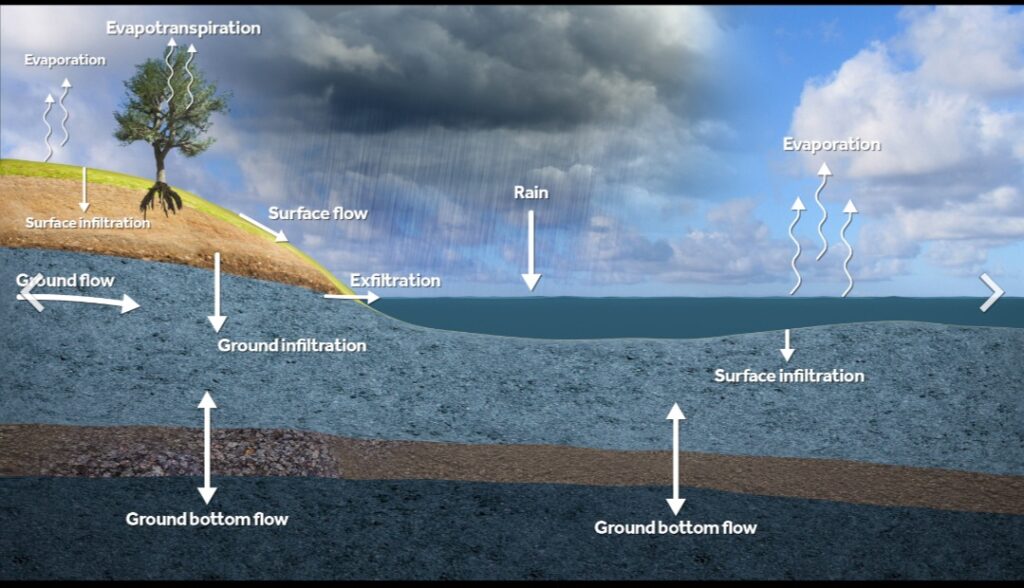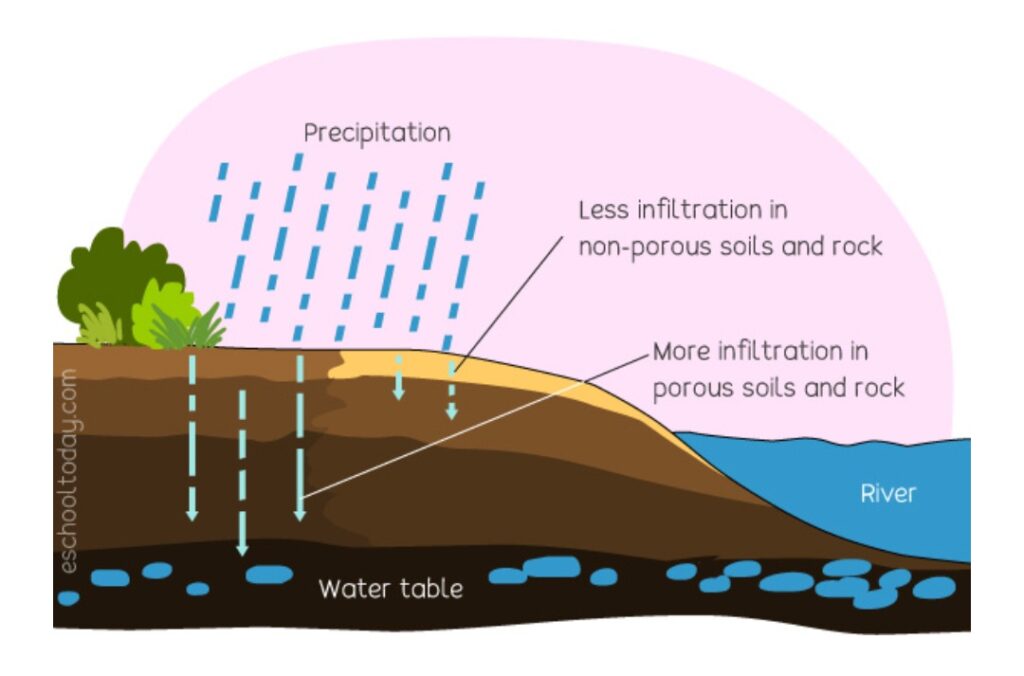
When water comes down as precipitation, some of the water will seep down into the ground where it stay for some time until plants take it up. Som seeps down below ( infiltrates) to reach the underground water, some moves horizontally to reach nearby water while some makes its way back to the surface as surface water .
The process by which water from the ground’s surface enters the soil is called water infiltration.. It is a key part of the water cycle, and is commonly studied in hydrology and soil sciences.
The infiltration capacity is defined as the maximum rate of infiltration. It is most often measured in meters per day but can also be measured in other units of distance over time if necessary. The infiltration capacity decreases as the soil moisture content of soils surface layers increases. If the precipitation rate exceeds the infiltration rate, runoff will usually occur unless there is some physical barrier.
HOW INFILTRATION OCCUR
Water can get to the soil through various means. It can get to the soil through precipitation, irrigation water, rise of water table and also from surface water bodies. The water cycle is an important aspect of water that infiltrates into the soil.
The water cycle starts when water vapor condenses in the clouds and falls to Earth as rain, snow, sleet, or hail. This water can move in several different ways. It can be collected in one spot, runoff, infiltrate through the ground or be taken up by plants or animals. This water returns to vapor by evaporation or transpiration until it condenses again and starts the cycle over. This water from rain or irrigation or other sources enters the soil through porous areas, where the soil grains have enough space for water to pass between them. The water then percolates through the soil and rock until it reaches a saturated zone, where the water table is located.
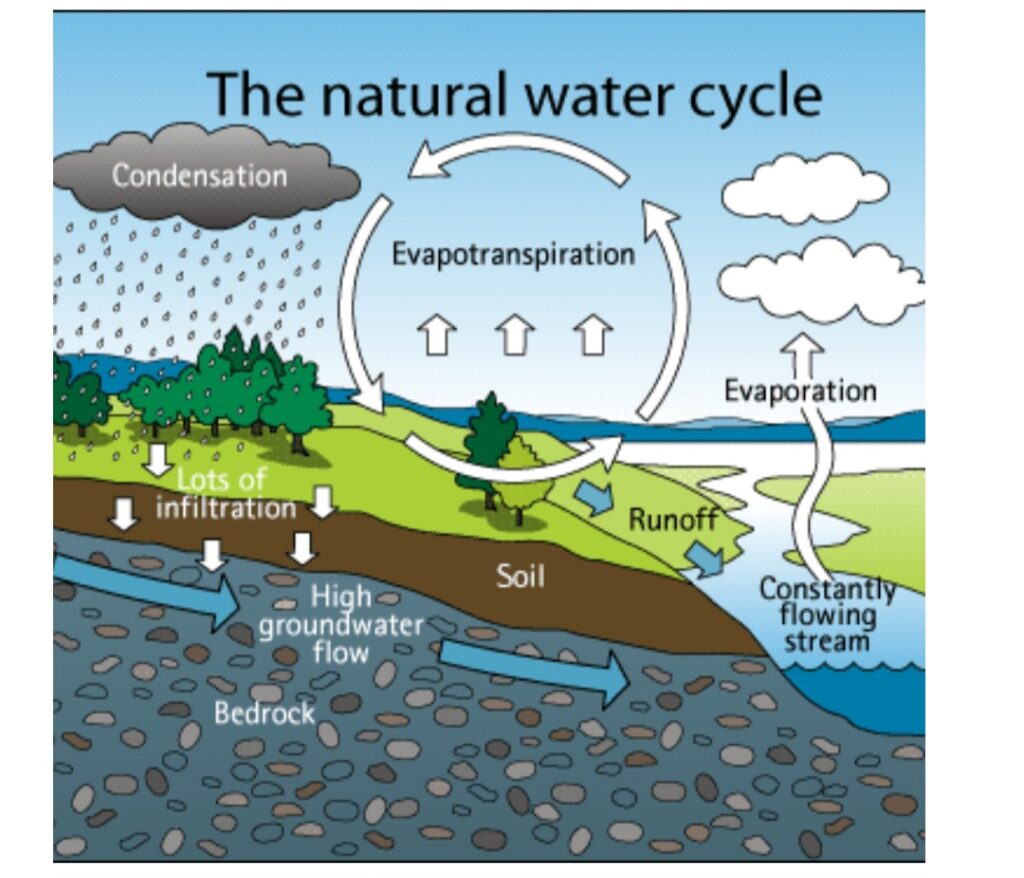
CAUSES OF INFILTRATION
Infiltration is caused by factors such as; gravity, capillary forces, adsorption, and osmosis. Many soil characteristics can also play a role in determining the rate at which infiltration occurs. Such soil characteristics include soil texture, soil porosity, compaction, bulk density, Precipitation, Soil moisture content; Organic materials in soils; Land cover; soil structure, vegetation types, and soil temperature. etc.
FACTORS THAT AFFECT INFILTRATION
1. PRECIPITATION:
Rainfall leads to faster infiltration rates than any other precipitation event, such as snow or sleet. At the beginning of a rainfall, infiltration rates are usually higher preceded by a dry period, and decrease as the rain continues.
When precipitation occurs, infiltration increases until the ground reaches saturation, at which point the infiltration capacity is reached. After which infiltration slows down.
This precipitation – infiltration relationships depend on factors such as the rainfall intensity ,amount, type, duration and the vegetation properties of the local area. For example, the duration of rainfall can impacts infiltration capacity when at the initially state of rainfall, infiltration will occur rapidly as the soil is unsaturated, but as the rain continues, the soil will reach a state of saturation at which infiltration rate slows down. If the rain continues, the soil continues to becomes more saturated, leading to runoff. Also, if rainfall occurs on wet soils, runoff will occur.
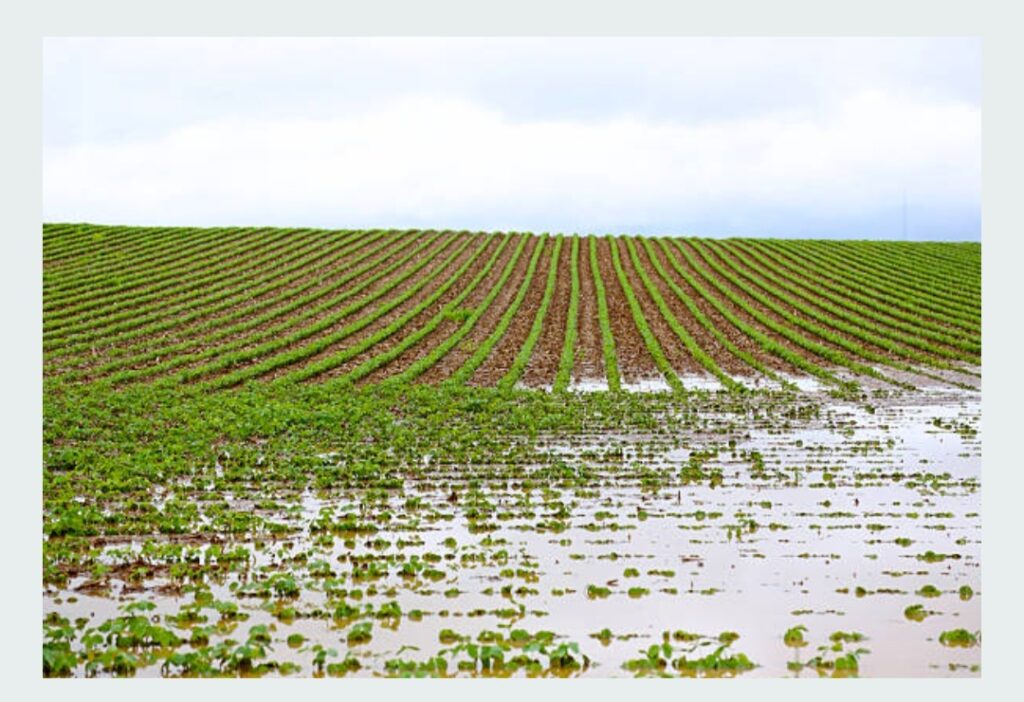
2 SOIL CHARACTERISTICS
a. SOIL POROSITY:
Soil porosity has a direct effect on infiltration. The higher the soil pore space, the higher the infiltration rate and vise versa. When soils have
higher porosity meaning more pore space then the rate of infiltration becomes higher. for example, coarse soils like sandy soils.
Also, Soils that have smaller pore sizes, such as clay, have lower infiltration capacity and slower infiltration rates than soils that have large pore sizes, such as sands. One exception to this rule is when the clay is present in dry conditions, in this case, the soil can develop large cracks which lead to higher infiltration capacity.
Soil porosity may be determined by Pore size distribution, soil texture and the subsoil horizons.
Dense subsoil horizons with low permeability can restrict rainwater infiltration. Deep tillage can improve subsoil permeability and allow more rainwater to infiltrate.
b. SOIL COMPACTION: Soil compaction also impacts infiltration capacity. When soils are compacted due to for example heavy machine movement on soils, this results in decreased porosity within the soils, which decreases infiltration capacity.
It should be noted that large pores are more effective at moving water through the soil than smaller pores. When these pores are sealed up as a result of compaction, infiltration rates will be reduced. This can significantly lead to increased runoff and flooding and poor water quality.

c. HYDROPHOBIC SOILS: Hydrophobic soil is soil that repels water instead of absorbing it. It is caused by a waxy residue that coat the soil particles, making it difficult for water to penetrate.
Hydrophobic soil can be common in sandy soils, dried-out potting mixes, and soils with unrotted organic matter.
Hydrophobic soils can develop after wildfires have happened, which can greatly diminish or completely prevent infiltration from occurring. Such soils have a lower rate of water infiltration than non-hydrophobic soils. This is because water molecules are attracted to each other by cohensive force and have a weak ability to bond with the waxy soil particles. Therefore, droplets of water are formed with a high contact angle. This high surface tension of the water prevents the water droplets from spreading out over a large area.
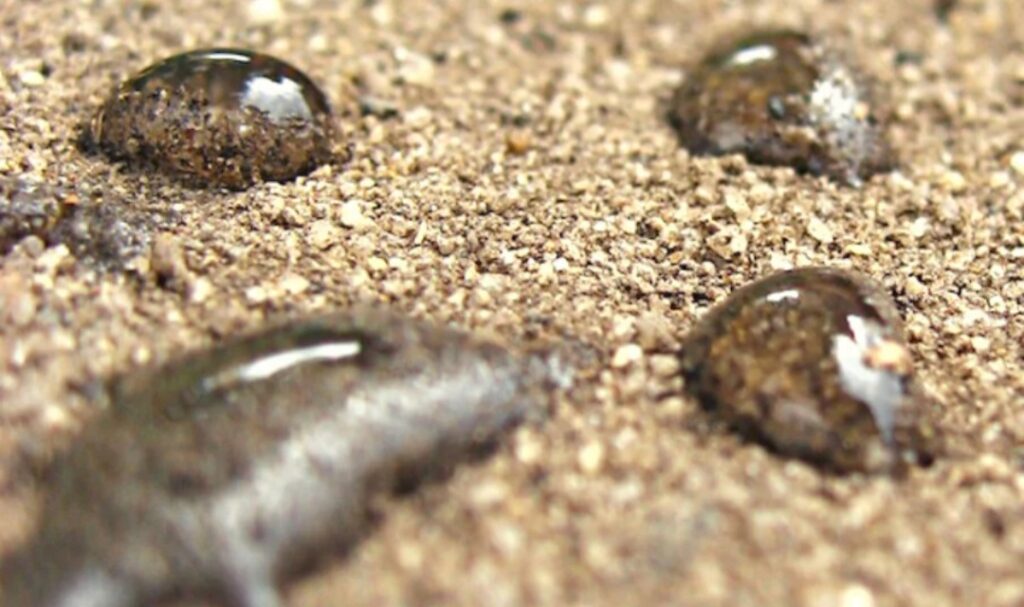
d. SOIL MOISTURE CONTENT:
Saturated soils have no capacity to hold more water. This means that infiltration capacity has been reached and the rate of infiltration cannot increase beyond this point. This leads to much more surface runoff. When soil is partially saturated then infiltration can occur at a moderate rate and fully unsaturated soils have the highest infiltration capacity.
e. ORGANIC MATERIALS IN SOILS:
Organic materials like manure and plant residue which decompose to form organic matter and humus can improve soil infiltration by improving soil structure. Organic materials bind soil particles together into aggregates, which improves soil structure. When soil structure is improved, water flow downward through the soil easily and also improve the ability of the soil to absorb and hold water. This makes organic matter to improve infiltration rate.
Vegetation contains roots that extend into the soil which create cracks and fissures in the soil. This create rapid infiltration and increased infiltration capacity. Vegetation can also reduce the surface compaction of the soil which again allows for increased infiltration. When no vegetation is present, infiltration rates can be very low, which can lead to excessive runoff and increased erosion levels. Similarly to vegetation, animals that burrow in the soil also create cracks in the soil structure. Thus, increasing infiltration rate.
f. IMPERVIOUS SURFACES:
Some land areas are usually covered with impervious surface or impermeable surfaces especially during construction. Example is pavement, tired areas etc. infiltration cannot occur at such land areas because water cannot infiltrate through an impermeable surface. This can leads to increased runoff. Areas that are impermeable often have drainages that drain directly into water bodies, which means no infiltration occurs.
g. LAND COVER:
Vegetative cover over the land also have great impact on the infiltration capacity. Vegetative cover can lead to more interception of precipitation, which can decrease intensity of rain droplets leading to less runoff, more interception and increased infiltration rate. Increased abundance of vegetation also leads to higher levels of evapotranspiration which can decrease the amount of infiltration rate. Debris from vegetation such as leaf cover can also increase the infiltration rate by protecting the soils from intense precipitation events. Trees have strong roots that can penetrate deep into the soil, which promotes infiltration.
In semi-arid savannas and grasslands, the infiltration rate of a particular soil depends on the percentage of the ground covered by litter, and the basal cover of perennial grass tufts. On sandy loam soils, the infiltration rate under a litter cover can be nine times higher than on bare surfaces. The low rate of infiltration in bare areas is due mostly to the presence of a soil crust or surface seal. Infiltration through the base of a tuft is rapid and the tufts funnel water toward their own roots.
h. SLOPE
Infiltration increases with increasing slope gradients and runoff decreases.
When the slope of the land is steeper, runoff occurs more readily which leads to lower infiltration rates. Gentle slopes on the other hand, lead to decreased runoff, which favours infiltration.
INFILTRATION RATE
The rate at which water enters the soil is called the infiltration rate, and is usually measured in inches per hour. Infiltration capacity is the maximum rate at which infiltration can occur.
MEASURING INFILTRATION
Infiltration rates can be measured using devices like infiltrometers, rainfall simulators, and infiltration tests.
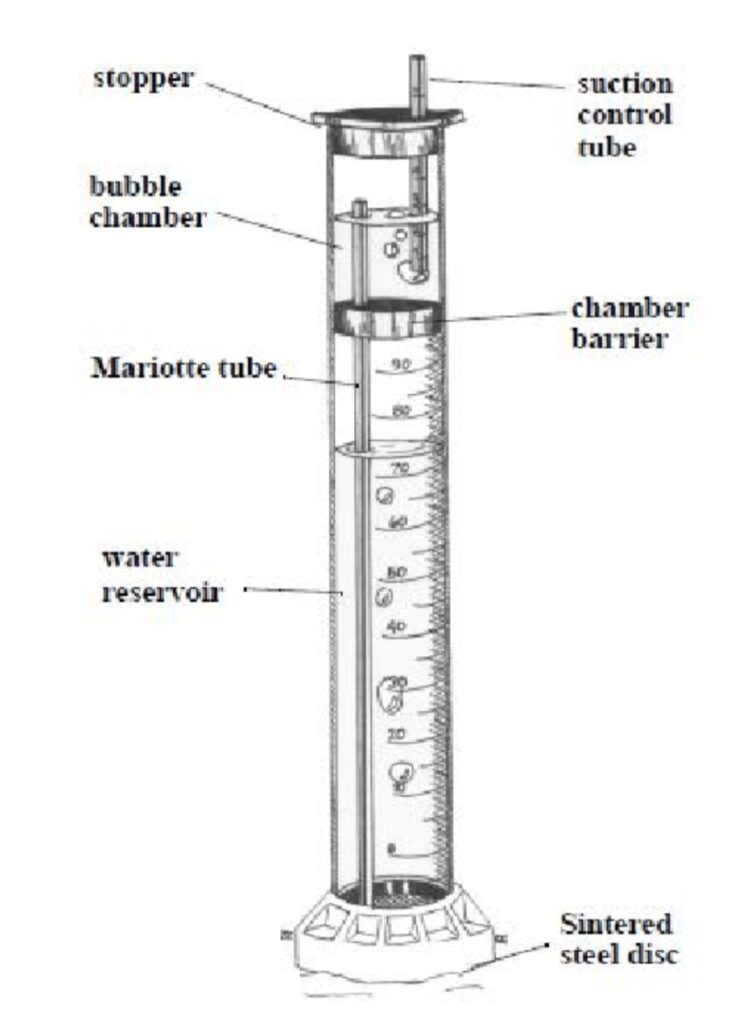
RUNOFF
If the rate of precipitation is faster than the rate of infiltration, runoff will occur unless there is a physical barrier. Also, when water is supplied to the soil at a rate that exceed infiltration capacity (saturation), such water result in runoff especially on slopy areas or pond up on flat surfaces. When runoff occur on bare land or poorly vegetated soils, erosion will occur. The runoff will carry along with it nutrients, applied agrochemicals and soils to deposited them elsewhere. Thus decreasing soil health and productivity.
Ponded water on the soil surface means the soil is oversaturated and pore spaces are overfilled with water. Therefore, poor aeration of soil occurs which leads to anaerobic condition within that soil. This therefore leads to poor root function and plant growth, reduced nutrient availability, reduced cycling by soil microorganisms, and soil strength decreases. Also, soil structure is destroyed, high rate of soil particle detachment occurs, and the soil becomes more erodible.
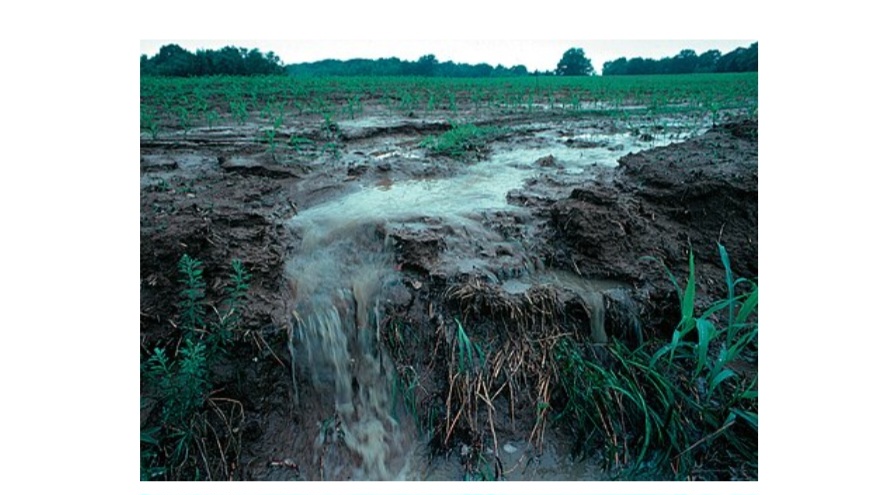
The ponded water are also exposed to increased evaporation, hence reduced water availability to plants.
HOW TO IMPROVE SOIL INFILTRATION.
Several conservation practices result to reduced infiltration. By proper consideration and application of these practices, infiltration will be improved. Some of the conservation practices that reduce infiltration include: burning, harvesting of crop residues, tillage methods and soil disturbance activities, prevention of soil organic matter decomposition and accumulation, equipment and Livestock trafficking, and reduced soil porosity.
To maintain and improve soil infiltration, conservation measures should be properly applied. such measures include: Proper managing of crop residues, increasing vegetative covers, increasing soil organic matter, practicing zero tillage or non disturbance of soil, protect soil from erosion, encourage development of good soil structures, and breaking of compacted areas in soil etc.
